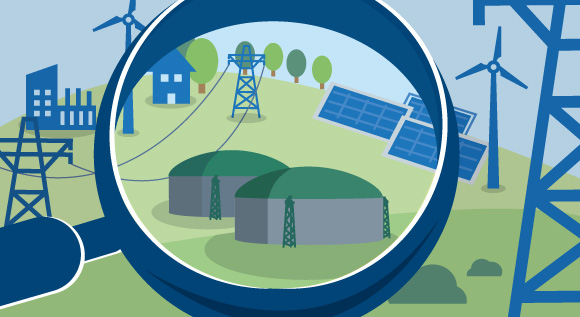What is ‘biomass’?
Lighting a fire in the fireplace in winter means using biomass to generate warmth. Read on to find out which materials, apart from wood, classify as biogenic energy sources and how they can be used to generate warmth, electricity or even fuel.
 © BMWi
© BMWiGenerating climate-friendly energy from organic waste and plant-based raw materials
Even Fred Flintstone knew how to light a fire, heat up food and keep himself warm. These skills are one of the first cultural achievements of human beings. Wood is the oldest fuel used by humans and, as a regenerative raw material, it is an important energy source even today.
Wood makes up by far the largest share of biomass usage for energy in Germany. In one and multi-family houses, logs of wood are burned in the fireplace, and wood pellets and wood chips fuel the heating system. However, heat generation is not limited to small and medium-sized systems. Local and district heating systems can be powered by larger wood-burning systems. These use residual wood from forests and industry in particular.
We now also use plant-based raw materials and organic waste to generate warmth, electricity or fuel. These include corn and wheat plants, straw, sugar beet, reed and other grasses, but also residual material such as manure, biowaste and sewage sludge. Biomass as a renewable energy source plays an important role in the energy transition in Germany. And it is also climate-friendly. The creation of biomass, specifically the growth of plants, causes the greenhouse gas carbon dioxide to be withdrawn from the atmosphere. Later, through the burning or rotting of biomass, the same amount of carbon dioxide is released back into the atmosphere. The climate footprint of biomass is therefore neutral, but only as long as the amount consumed does not exceed the amount that is regenerating. In other words, if more wood is burned than trees regrow, there is a certain level of climate damage.
Versatile use in heating, electricity and fuel
Not only heat can be generated from wood and other solid biogenic fuels, but also electricity. One method is to generate steam using the heat produced by the burning of wood. This steam is then used to power a turbine or an engine. The residual heat can then be used for heating buildings or in industrial drying processes. This is called combined heat and power generation, a method used in so-called cogeneration power plants.
Biomass can also be used as fuel for transport. Oily plants, such as rapeseed, can be pressed, processed and transformed into liquid fuel known as biodiesel. This biodiesel is an important ‘green’ fuel. Other climate-friendly energy sources for the transport sector are biomethane and bioethanol.
Bacteria help generate energy
Not every type of biomass can be burned effectively. Corn and wheat plants, manure, sewage sludge or biowaste release energy when fermenting. During decomposition of organic material through specific methane bacteria, flammable biogas is created which can be used to generate electricity or as a fuel. Biogas plants are methane reactors specifically built for this purpose. They provide ideal conditions for the creation of energy-rich gas. These process environments are low in oxygen, and temperatures are set at a bacteria-friendly level between 30 and 37 degrees.
Growth in electricity generation up to 2015
Around 50 million kilowatt hours of electricity were generated from biomass in solid, liquid and gas form in Germany last year. In 2004, it was only around 10 million kilowatt hours. The consumption of wood and wood pellets in private households has also increased in the past few years, which has led the share of biomass in renewable energy sources in the heating sector to retain its dominance, sitting at 87,8 per cent in 2015.
The highly efficient use of biomass for electricity generation will continue to be funded by the Renewable Energy Sources Act. In the future, the remuneration will be determined through auctions. The market incentive programme for renewable energy sources also supports biomass installations, especially in the heating sector. Further information can be found here.

